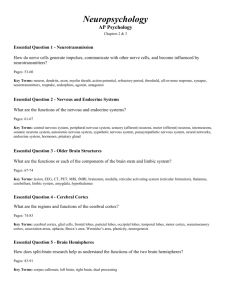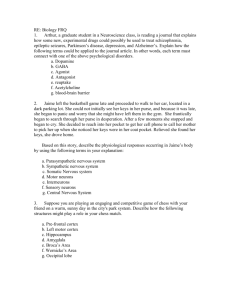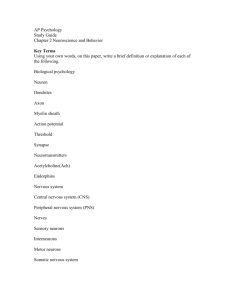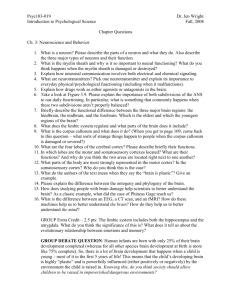Nervous systems
advertisement
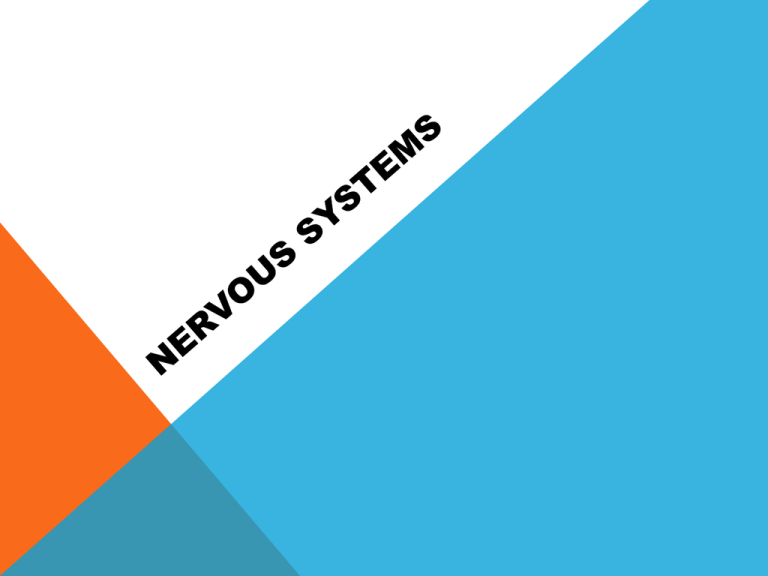
NERVOUS SYSTEMS Nervous Systems are broken down into divisions based on location and processing. http://www.youtube.com/watch?v=3XEoz_rf40A THE ORGANIZATION OF THE NERVOUS SYSTEM CENTRAL NERVOUS SYSTEM (CNS) Composed of the brain and the spinal cord. Serves as the bodies “command central”. CNS--BRAIN The brain: Makes complex decisions, coordinates the body’s functions, and initiates our behaviors. CNS--- SPINAL CORD Spinal Cord Plays the supportive role. Serves as a neural cable connecting the brain with parts of the peripheral system. It takes charge of simple reflexes that do not require brain power. PERIPHERAL NERVOUS SYSTEM (PNS) Connects the CNS with the rest of the body through bundles of sensory and motor axons. Sensory and motor axons= nerves PNS Carries messages between the brain and the sense organs, and the muscles. Carries messages that tell your brain about sense. Carries outgoing signals that tell muscles and glands how to respond. SOMATIC DIVISION Connects sense organs to the brain and links the CNS with the body’s skeletal muscles. The muscles that control voluntary movements..= Autonomic AUTONOMIC *Self regulating* Carries signals that control our internal organs to perform their jobs. example- digestion The body does the processes unconsciously AUTONOMIC Is broken down into two divisions: 1. Sympathetic 2. Parasympathetic SYMPATHETIC Arouses the heart and other organs in stressful situations when our responses must be quick and powerful. Known as “fight or flight” This system also generate adrenalin and emotions during suspenseful movies Example: Lifting a car of your child. PARASYMPATHETIC Calming sensation and applies the “neutral brakes”, returning our internal response to calm down and collect our emotions http://education-portal.com/academy/lesson/thesympathetic-and-parasympathetic-nervoussystems.html ENDOCRINE SYSTEM Blood stream carries information along with oxygen and nutrients. The glands that make up the endocrine system transmit information by releasing hormones into the bloodstream. ENDOCRINE SYSTEM The body’s chemical messenger system. HORMONES Chemical messengers that influence not only body functions but behaviors and emotions as well. Once secreted into the blood, hormones circulate throughout the body until delivered to their target. ENDOCRINE SYSTEM In normal conditions the Endocrine System works in parallel with the parasympathetic system. But in crisis the Endocrine System shifts into Sympathetic gear! PITUITARY GLAND At the base of your brain a “master gland” pituitary gland attempts to keep all of the endocrine responses under tight control. This gland does this by sending out hormone signals through the blood HOW DOES THE BRAIN PRODUCE BEHAVIOR AND MENTAL PROCESSES? The brain is composed of many specialized modules that work together to create mind and behavior. http://www.youtube.com/watch?v=u-xEhxMZOcs LAYERS OF THE BRAIN Brain Stem and cerebellum Drive vital functions, such as heart rate, breathing, digestion Limbic System Adds emotions, complex motives, increased memory abilities Cerebrum Enables reasoning, planning, creating, problem solving BRAIN STEM Links spinal cord with brain. Nerve pathways that carry messages up and down spinal cord pathway. It has 5 components: Medulla, Pons, Reticular Formation, Thalamus, Cerebellum THE BRAIN STEM AND CEREBELLUM MEDULLA Regulates basic body functions. Acts on auto-pilot, meaning without our conscious awareness. Example: breathing, blood pressure, heart rate. PONS Bridge that connects the brain stem to the cerebellum. Houses nervous circuits that regulate sleep and dreaming. RETICULAR FORMATION Pencil shaped bundle of nerve cells that forms the brain stem’s core. One of its jobs is to keep the brain awake and alert. It also monitors the incoming stream of sensory information and directing attention to novel or important messages. THALAMUS Directs all the brain’s incoming and outgoing sensory/motor traffic. It receives information from all the senses (except smell) and distributes it to appropriate processing circuits throughout the brain. CEREBELLUM “Little Brain” Controls complex movements we perform without conscious thought. Works cooperatively with the brain stem and higher brain centers to control the complex movements. example- dancing, walking to class. WORK IS AUTOMATIC LIMBIC SYSTEM Processes memories, regulates complex motives and emotions involved in feelings of pleasure and pain. Two important Limbic structures: 1. Hypothalamus 2.Hippocampus 3. Amygdala THE LIMBIC SYSTEM Hypothalamus – Serves as the brain’s bloodtesting laboratory, constantly monitors blood to determine the condition of the body. HYPOTHALAMUS Constantly monitors blood, detecting small changes in body temp. Major role in motivation Sends neural messages to “higher processing” areas in the brain, making us aware of the needs it senses. (hunger, thirst, etc.) Also control the Pituitary Gland Links the nervous system with endocrine system. Regulates the body’s responses during emotional arousal. THE LIMBIC SYSTEM Hippocampus – Involved in establishing longterm memories. • • shaped like a seahorse. Connects your present with your past and to help you remember the location of things in space. HIPPOCAMPUS It’s job is to connect your present with your past and help you to remember locations of things in space. It is in the shape of a horseshoe. The hippocampus is the part of the brain that is involved in memory forming, organizing, and storing It acts as memory indexer by sending memories out to the appropriate part of the cerebral hemisphere for longterm storage and retrieving them when necessary. = Long term memories THE LIMBIC SYSTEM Amygdala – Involved in memory and emotion, particularly fear and aggression. AMYGDALA It’s job is emotion and memory It is almond shaped, 1 inch long, and located within the temporal lobe. Example of emotion– fear and aggression It processes and stores memories of emotional events and is also involved in current emotional responses. Researchers also find that the amygdala in men and women respond differently to emotional situations. Example- if you witness a murder. This stores those vivid memories and can replay them to you. THE CEREBRUM Cerebrum – Topmost layer of the brain; the bulbous cap over the limbic system Cerebral cortex – Thin gray-matter covering of the cerebrum; carries on thinking and perceiving Cerebral hemispheres – The two walnut shaped halves of the cerebrum, connected by the corpus callosum THE FOUR LOBES OF THE CEREBRAL CORTEX Frontal lobes: movement and thinking. Parietal lobes: touch sensation and Occipital lobes: contain visual cortex, spatial relationships. Temporal lobes: process sounds, including speech. LOBES Frontal: Models work together to perform our higher mental functions such as planning, deciding, and perceiving. Motor Cortex: Controls the body’s motor movement by sending messages via motor nerves to the voluntary muscles. PARIETAL LOBE Patches of cortex that specialize in sensation. It integrates sensations with memories. EX-Warmth, smoothness Parietal Lobe is composed of: Somato Sensory 1. Serves as the primary processing for sensations. 2. It relates information to mental map of the body to help locate the sources of these sensations. OCCIPITAL LOBE Receive stimulus relayed from the eyes to the visual cortex. Visual cortex constructs our moving picture of the outside world. TEMPORAL LOBE Auditory Cortex: helps make sense of sounds Also processes speech sounds. COOPERATIVE BRAIN No individual part of the brain takes on the sole responsibility for emotion, personality, or memory. Every mental and behavior process coordinates and cooperate with many brain networks ASSOCIATION CORTEX Association cortex – Cortical regions that combine information from various other parts of the brain. Links everything together** CEREBRAL DOMINANCE Cerebral dominance – Tendency of each brain hemisphere to exert control over different functions Aphasia – The loss of speech caused be brain damage Spatial orientation – Process of locating one’s body or other objects in space **BROCA’S AREA!!! **Wernicke’s Area SPECIALIZATION OF THE CEREBRAL HEMISPHERES Left Hemisphere •Spontaneous speaking and writing •Responses to complex commands •Word recognition •Memory for words and numbers •Sequences of movements •Feelings of anxiety •Positive emotion Right Hemisphere •Repetitive but not spontaneous speaking •Responses to simple commands •Facial recognition •Memory for shapes and music •Spatial interpretation •Emotional responsiveness •Negative emotion THE SPLIT BRAIN Split-brain patients – Individuals who have had the corpus callosum surgically severed Duality of consciousness – Condition in which a split-brain patient has a separate consciousness in each hemisphere WINDOWS TO THE BRAIN EEG (electroencephalograph) – Device for recording brain waves, typically by electrodes placed on the scalp Brain waves – Patterns of electrical activity generated by the brain WINDOWS TO THE BRAIN Epilepsy – Brain disorder that is often marked by seizures and loss of consciousness; caused by out-of-control electrical activity in the brain. Lesions – Tissue damage that results from disease or injury WINDOWS TO THE BRAIN Brain scans – Recordings of the brain’s electrical or biochemical activity at specific sites CT scanning (computerized tomography) PET scanning (positron emission tomography) MRI (magnetic resonance imaging)

